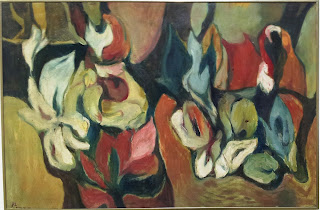Latiff Mohidin Retrospective @ NVAG (I)
Never have I seen a retrospective for a single artist so comprehensive - 340+ works spanning 60 years, exhibited in 4 galleries across 2 floors. Latiff Mohidin went to the Ethnological Museum of Berlin in the 1960s, brought back German abstract expressionism to Malaysia, and has never looked back since.
 |
| Flower in a Tree (1962) |
The "Pra-Berlin" and "Berlin" series provide an interesting insight into Latiff's early years, a decent artist that has yet to find his voice, where an instantly recognizable painterly style will emerge a decade later. The inclination to draw nature, with clear blocks of primary colours a la Matisse, signals the advent of a great artist in 'Flower in a Tree'. A painting nearby of a Kabuki actor, also implied the European inclination towards an Eastern romanticism.
| Selections from the Pago-Pago series (1965 - 1967) |
Many sketches are displayed to allow the interested viewer, an insight into the evolution of the "Pago-Pago" series. Agave plants and regional architecture feature prominently, interlocking to create symbolic totem pole structures. One of Malaysia's most iconic paintings was born when this individual form, was supplemented with a horizon and a sun. However, I found many variations of the singular "Pago-pago" more interesting, either because of its vivid colour combinations, or its complex design.
Latiff also explored Pago-pago configurations in a landscape setting; In 'Pago-Pago Kelam', individual totems float atop a dark background, the ochre tones and formal composition creating a sombre environment. Strong contrasting colours and inverted pyramid heads feature in the other Pago-pago landscapes, all beautiful oil paintings in its own right. To explore Latiff's works in a chronological manner, a detour to the smallest gallery is required at this time. Exhibited here are the visually interesting etchings of geometrical forms, such as 'Nocturno', made during the artist's time in New York as a printmaking student.
 |
| Nocturno I (1969) |

Comments
Post a Comment